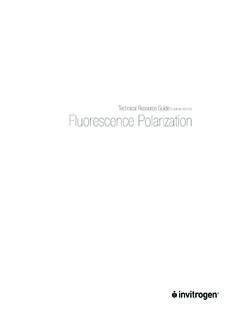Transcription of Introduction to Fluorescence Spectroscopies I. Theory
1 Page 1 of 9 March 22, 2006; Revised January 26, 2011 for CHMY 374 Adapted for CHMY 362 November 13, 2011 Edited by Lauren Woods December 2, 2011 17mar14, ; 1feb17 P. Callis Introduction to Fluorescence Spectroscopies I. Theory Patrik Callis and Karl Sebbey (Adapted from Clarke RJ, Oprysa, A. Fluorescence and Light Scattering J. Chem. Ed. 81(5) 705-707 2004) All life appears to be nurtured by the excitation of electrons by light in photosynthesis. The vision enjoyed by higher life forms begins with the electronic excitation of a conjugated polyene.
2 1. Introduction Motivation To understand our very existence we must understand the absorption and emission of light. From a practical standpoint, there is an explosion in the use of fluorescent dyes to visualize processes in living cells and other materials at unprecedented detail, and in breathtaking color. These images are a new art form. Fluorescence -based assays are also playing a rapidly increasing role in areas traditionally served by radioactive assays. Major reasons for this are the high sensitivity of Fluorescence detection and its environmental friendliness.
3 In addition, light emitted within 100 fs following pulses of light as short as 10 fs represent the current frontier for the observation of fast chemical events. During this experiment we will learn about a conventional (steady state) fluorometer and use it to observe behavior of a common fluorescent dye, fluorescein that illustrates general principles of Fluorescence and Fluorescence excitation spectra, including Fluorescence quenching. We will also learn about and observe light scattering. Both Fluorescence and light scattering involve the irradiation of a sample with light and the detection of the light emitted by the sample (generally at right angles to the incident beam).
4 Because the experimental set-up for the observation of both phenomena is the same, Fluorescence and light scattering are often both observed in a single experiment. In order to avoid misinterpretation of the data obtained, it is, therefore, important to recognize the origin of any particular signal. The aim of this experiment is to develop tactics for distinguishing between signals originating from Fluorescence and those originating from light Page 2 of 9 scattering. Before this can be done, however, we must first have an understanding of the physical basis of both phenomena.
5 2. PRINCIPLES AND Theory Fluorescence If a molecule is irradiated with light whose energy corresponds to the energy difference between its ground electronic state and one of its excited electronic states, absorption of a photon can occur and a rearrangement of the molecule's electronic distribution occurs as it reaches the excited state. For example, an electron may be excited from a molecular orbital to a * molecular orbital. Because light absorption only involves the movement of electrons (no nuclear rearrangement) and electrons are very light (approx.)
6 1/2000th of the mass of a proton), light absorption is a very fast process. The quantum event is over a very short time interval, about 1 femto-second (10-15 s). Once excitation of the molecule has occurred by the absorption of the energy of a photon, the molecule can subsequently return to the ground state by losing its energy in two possible ways: 1) by transferring heat to the surroundings (radiationless transition), 2) by the emission of light ( Fluorescence or phosphorescence). Either path may dominate, depending on the nature of the molecule.
7 The Fluorescence quantum yield ( , the ratio: photons emitted/photons absorbed) can range from < 10-5 to near 1. Figure 1: Jablonski diagram: photophysical processes (Note: Internal conversion happens from S1 also.) The absorption and emission of light is nicely illustrated by the energy level diagram Vibrational relaxation Page 3 of 9 suggested by A. Jablonski (1935) (see Fig. 1). The ground, first, and second electronic states are depicted by S0, S1, S2, .., respectively. The letter S (in this context) indicates a singlet excited state, in which the electrons remain paired (total spin = 0) during the excitation.
8 In a triplet state (T), the electron spins are more parallel, and total spin = 1). At each of these electronic energy levels the fluorophores can exist in a number of vibrational energy levels, depicted by 0, 1, 2, etc. (That is a cartoon. They extend to S1 and beyond, and the number of states get enormously crowed!) It is important to note that the energy levels can be modified by interaction of the fluorophore with surrounding solvent molecules, but such solvent effects are not included in the diagram. Following light absorption, several processes usually occur.
9 A fluorophore is usually excited to some higher vibrational level of either S1, S2, or higher. (You are familiar with this from the UV absorption experiment earlier in the course.) The overlap of ground state vibrational wavefunction with higher vibrational states of the upper electronic state (which gives the Franck-Condon factors) allow vibrational energy of up to ~ 4000 cm-1 to be reached along with the electronic excitation. This is very hot! (Recall that kBT = 200 cm-1 near room temperature.) So, immediately (~1 ps) the molecule cools off by spreading the energy to the cool solvent.
10 That is called vibrational relaxation on the diagram. Molecules in condensed phases (liquid or solid) rapidly relax to the lowest vibrational energy level of S1 by a combination of vibrational relaxation and changing electronic state if initially above S1. Changing electronic states without changing spin is called internal conversion and generally occurs on the time-scale of 1 ps (10-12 s) also. Again the excess energy is lost as heat to the surroundings. This process could continue all the way to becoming a cold ground state, S0, but except in rare instances, the process of internal conversion from S1 to S0 is slow , because of the larger energy gap between S1 and S0.










